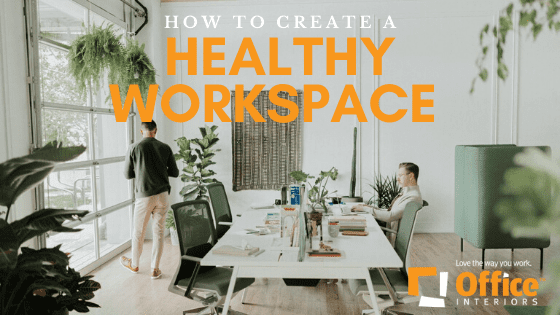What is the first thing you see when you look at your office desk? Is your space closed off and can you communicate effectively with your coworkers? Or is your space nothing but an empty desk? Where you work and how you keep your personal workspace has a lot to do with your overall health and wellbeing and it has the power to positively or negatively affect both.
Maintaining a healthy work environment is more than just clearing away the clutter. It’s about creating somewhere that promotes good work habits, provides comfort throughout the day and encourages productivity.
When you take the time to declutter and revamp your workspace or office, not only will it reduce stress but it also showcases a certain level of professionalism. If after looking at your workspace and you feel like it’s time for a change, start by following these steps for creating a healthy workspace.
Provide Furniture That Encourages Good Posture
This first step should almost go without saying. By providing different environmental settings that encourage people to sit, stand, and move throughout their day is a must in any modern-day office.
When selecting a quality ergonomic chair; make sure all the furniture settings support good posture for long periods of sitting. Most good furniture suppliers will also come and give your staff a lesson in ergonomics and chair adjustments to encourage good posture.
However, simply having a chair that supports good posture is just the first step to a healthy workspace. Next, you need to get the people in your office up and moving.
Get People Active
Giving employees the opportunity to be active while at their place of work is vital to a healthy workspace and there are many ways in which this can be accomplished.
- Redesign your desk to provide opportunities for standing and regular stretching. Standing desks are an excellent solution to this, but if your company doesn’t supply standing desks, there are easy DIY options to get you standing.
- Encourage people to take the stairs and walk to off-site meetings instead of taking taxis or personal vehicles.
- Providing staff with a page of simple stretches to do at intervals throughout the day is also useful and promotes good circulation.
Create A Diverse Workplace
Having a variety of spaces for your employees to switch up their workday is important. This can include quiet, collaborative, individual, social, and focused areas. These can be created with mobile screens, curtains, or furniture settings and don’t necessarily have to be hard walls.
Those that work in an office can spend upwards of 7 hours per day sitting in the same spot. This means that they are doing a lot of repetitive tasks and engaging in behaviours that may cause ergonomic injuries.
When employees have more options in their workspace to encourage collaboration within their team, those choices are both mentally and physically stimulating and promote autonomy among teams and individuals.
Contribute To Workplace Wellness
Air quality and access to natural light are important contributors to wellness in the workplace. If you are lucky enough to have an outdoor area, use this to its fullest potential. If your natural light is limited, however, schedule regular intervals throughout the day to get up and go outside.
If your office doesn’t lend itself to plenty of natural light, investing in some lamps and decorative lighting will go a long way in creating a good work environment. In order to work effectively, it’s necessary to have effective lighting.
A well-lit area will make it easier to stay focused and reduce eye strain. A bright space with lots of natural light is more likely to make people feel happy and energized whereas a dark and dreary workspace can make employees feel tired and bored.
Additionally, hosting monthly team barbecues, outdoor meetings when weather permits, and encouraging staff to eat lunch outside or away from their desks also contribute to overall wellness in the workplace.
Create A Team By Connecting People
Employees and visitors need to feel connected to each other. Communication barriers should be minimized where possible, and being able to easily see if people are in the workspace helps them feel connected, supported, and like part of a collaborative team.
Team members need to feel as though they can connect with an organization on both a cultural and social level. Creating a sense of belonging is about finding activities or events that best suit the culture of the business. Feeling that they belong to a group of like-minded people helps a team develop deep, long-lasting relationships, and in times of stress, these connections can be invaluable.
The open-layout office design is quickly becoming the norm and there are many added benefits of adopting this form of office layout. Employees may experience reduced stress and these layouts promote collaboration, reduce costs and offer flexibility.
Use Technology To Collaborate
A combination of face-to-face and virtual workplace communication is essential in today’s workplace, however, you don’t need expensive technology to support this. Technologies such as Microsoft Teams and Slack are easily accessible and promote the collaborative development of products and services.
Integrating technology like M365 into the workplace means that individuals have greater control over their own work/life balance as they have much more flexibility in how they communicate and collaborate with each other.
Have More Questions About Your Workspace?
Feeling comfortable and calm in your office space are basic needs that contribute to your overall work performance. Redesigning your workspace is one small thing you can do to help you feel healthier, happier, and more productive.
Our Office Ergonomics Guide answers all the questions our customers most frequently ask us, such as:
- What is ergonomics and Why is it Important?
- How does Office Ergonomics Create Value?
- Most Common Ergonomic Hazards In Every Office
- And much, much more.
Cody Turner
Digital Content Specialist
Office Interiors



